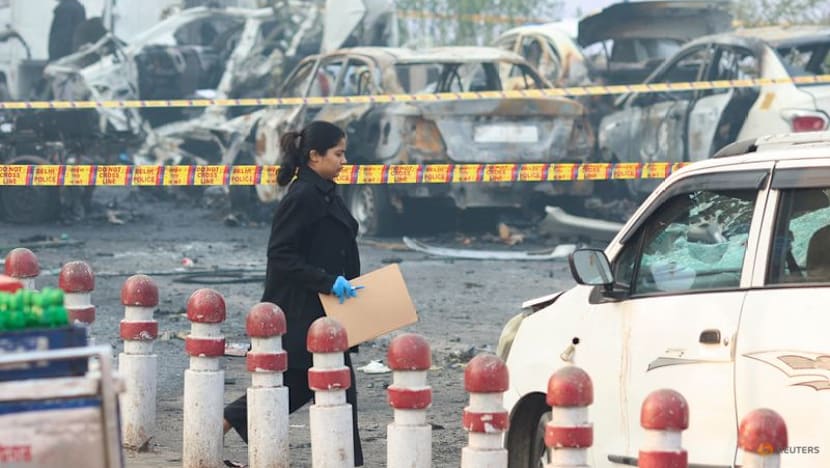Commentary: Is another Pakistan-India flare-up inevitable?
While the ceasefire may have temporarily put hostilities to an end, recent fissures point to the possible reignition of military adventurism from both sides, says Hannan Hussain of Initiate Futures.

An Indian army soldier stands guard as a drone takes a flight during a military drill along the Line of Control between India and Pakistan during a media tour by the Indian army in Indian-controlled Kashmir's Akhnoor sector on May 19, 2025. (File photo: AP/Channi Anand)

This audio is generated by an AI tool.
ISLAMABAD: Recent bombings in the capital cities of India and Pakistan have ratcheted up tensions in a region fraught with conflict.
On Nov 10, a car blast outside Delhi’s historic Red Fort killed at least 15. India’s counter-terrorism agency has identified the alleged suicide bomber and an accomplice and said they both hail from India-administered Kashmir.
Just a day after the Delhi car explosion, a suicide bomber killed at least 12 outside Islamabad’s district court. Authorities have arrested four members of TTP, also known as the Pakistani Taliban, in connection with the attack.


These bombings, though not thought to be related to each other, have put Pakistan and India on edge. Six months have passed since the nuclear archrivals exchanged heavy fire, when tensions over the contested Kashmir region were at a high after the Pahalgam attack.
On May 7, India launched missile strikes on several sites in Pakistan and Pakistan-administered Kashmir, prompting Pakistan to retaliate with counterstrikes on Indian territory. A series of tit-for-tat attacks ensued on each side’s air bases and towns.
Backchannel talks eventually resulted in a ceasefire agreement on May 10, with United States President Donald Trump taking credit for brokering the deal.
While the ceasefire may have temporarily put hostilities to an end, recent fissures point to the possible reignition of military adventurism from both sides with severe consequences for global peace.
BELLICOSE RHETORIC
According to Islamabad-based think tank Centre for Research and Security Studies, Pakistan saw a spike in terrorist attacks in the third quarter of 2025 compared to the previous quarter, with Pakistani Taliban in the northwest and Baloch separatist groups in the southwest largely responsible. This may have enabled anti-Pakistan sloganeering during the Indian state election of Bihar, which framed Pakistan as a threat to India’s national security.
Bellicose rhetoric exchanged between India and Pakistan highlights these simmering tensions. In early October, Indian army chief Upendra Dwivedi said that Pakistan risks being wiped off the map if it does not stop its ‚Äústate-sponsored terrorism‚ÄĚ.
Days later, Pakistani Defence Minister Khawaja Asif remarked in a television interview that the chances of war with India are real and that Pakistan ‚Äúwill achieve a better result than before‚ÄĚ.
Such inflammatory statements stem from accusations from both sides of the other sponsoring terrorism amid decades-long territorial disputes. Pakistan for example accuses India of sponsoring groups such as the TTP and Baloch militants, while India contends that Pakistan supported The Resistance Front (TRF), responsible for the April Pahalgam terrorist attack which targeted mostly Hindu tourists.
The potential for political gains currently outweighs calls for de-escalation, so neither side has an incentive to back down in the near term. In Indian electoral politics, Pakistan remains a key variable to the right-wing BJP government’s electoral success. This is exemplified in the Bihar state election in November, where the BJP won by a landslide.
On Pakistan‚Äôs end, the army warned of ‚Äúcataclysmic devastation‚ÄĚ in case of future conflict with India. This appeals to domestic sentiment and establishes the army as an apolitical defender of the country‚Äôs sovereignty.
The worrying sign is that such rhetoric comes amid a downgrading of diplomatic ties with the High Commissions in New Delhi and Islamabad.
POSSIBLE TRIGGERS FOR CONFLICT
As a result, there are a few possible triggers for renewed conflict. An increase in cross-border attacks from terrorist groups may give either side the justification to mobilise forces amid populist rhetoric domestically. This may include military strikes on disputed territories such as Sir Creek to repel or deter what it considers to be state-sponsored terrorism.
Amid a notable absence of communication, the likelihood of military skirmishes, tipping both countries into a possible war, increases.
Additionally, the Indus Water Treaty of 1960, which allocates safe distribution of rivers between the two countries, has been suspended since April. This is a flashpoint because Pakistan has repeatedly warned that any Indian move to alter water infrastructure constitutes an act of war, and there are no signs that New Delhi plans to restore the treaty.
Conventional deterrence from nuclear war has also blurred since May. Drone warfare, cyber operations and increased surveillance entail that the speed of decision-making on both sides outpaces the process of diplomacy. Such scenarios require more than just fragile ceasefires to resolve simmering tensions.
For the international community seeking to prevent nuclearisation and war, there is reason for both caution and alarm as an existential threat to peace in South Asia exists.
The aforementioned variables demonstrate that a redux of the India-Pakistan conflict is probable. Regional actors should employ quiet diplomacy and real-time monitoring of conflict to prevent another conflagration.
Hannan Hussain is a Senior Expert at Initiate Futures, a global think tank.











